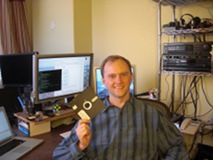My work and telepresence setup. As a work-from-home software engineer, I'm always looking for ways to improve communication with co-workers and clients to help bridge the distance gap. At the beginning of October, a colleague and I decided to devote the month to an extreme collaboration experiment we called Maker's Month. We had been using Google Hangouts for meetings with great effectiveness, so we asked ourselves: Why not leave a hangout running all day, to provide the illusion of working in the same room?
posted at 2012-11-20 21:51:08 US/Mountain
by David Simmons
tags: hangouts telepresence google video audio

